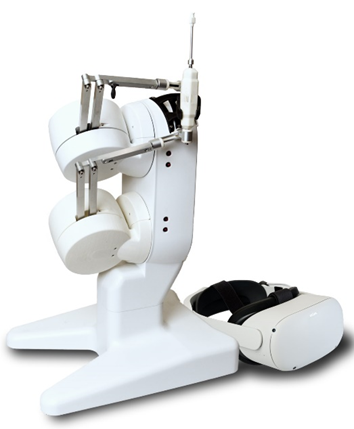Kitware Integrates iMSTK into Marion’s Virtual Reality Percutaneous Nephrolithotomy Simulator


Percutaneous Nephrolithotomy (PCNL) is a surgical procedure where large stones are removed from the kidney or upper ureter when they cannot be passed on their own. PCNL is a minimally invasive procedure that is performed under X-ray guidance using a nephroscope. This presents several advantages over more invasive procedures, including faster healing, shorter hospital stays, and lower post-operative trauma. However, proper surgical technique is critical to avoid complications such as bleeding, infection, and injury to surrounding organs.


Marion Surgical is a medical technology company that has designed and built a virtual reality surgical simulator with realistic haptics to teach minimally invasive surgical procedures. Their simulator is being used by medical device companies to train urologists to employ proper surgical techniques for PCNL procedures. The simulator uses a VR headset to place a user in a realistic and immersive operating theater and haptic force-feedback robots to render physical interactions between surgical tools and the virtual patient.
Building PCNL Using Kitware’s Interactive Medical Simulation Toolkit (iMSTK)
Marion selected Kitware to help build the physics-based simulation components of the PCNL simulator using iMSTK (Interactive Medical Simulation Toolkit). iMSTK is a free and open source C++ software toolkit that aids rapid prototyping of interactive multi-modal surgical simulations. Marion chose to use iMSTK because it offers strong technical solutions, has a permissive open source license that is friendly to commercial intellectual property exploitation, and is backed by Kitware’s long history of open source software implementation, support, and maintenance. One of the crucial parts of the procedure is access to the kidney, which requires the insertion of a needle through muscle and fat tissue in the patient’s back (between the ribs) and into the kidney to reach the target area (calyx) where stones reside. Kitware’s team of researchers and engineers helped the Marion team extend and integrate iMSTK’s tissue simulation modules to simulate the physical interaction of the needle with the skin, fat, and kidney tissues simultaneously. In building a customized version of iMSTK, Kitware helped Marion to (a) realistically simulate the biomechanical tissue behavior, (b) render the haptic (force) feedback in real-time, (c) recreate the puncture forces on the surface of the kidney, and (d) recreate the needle-tissue frictional forces.

PCNL in action
The video below shows the PCNL’s real-time needle-tissue interaction. A 5 degree of freedom (force feedback) haptic device setup is used to both track the user’s movements and render the forces. The simulator displays an update rate of 1000Hz using models with 293 vertices and 127 tetrahedral elements.
The Future of the PCNL Simulator
Marion’s PCNL simulator is currently being used by medical device companies and training hospitals to train surgeons in Europe, Canada and the US. The simulator was used at a hospital in Hamilton, Ontario for a surgical rehearsal. With consent of the patient – a urologist performed a trial run of the patient’s kidney stone case before he performed the actual case. The trial was a great success and the results of the study will be published soon in a peer reviewed journal.With the success of the Kitware-Marion collaboration, the team is pursuing other iMSTK integration opportunities with the Unreal Engine. Marion was recently awarded an Epic MegaGrant to work on integrating iMSTK with Unreal. Kitware and Marion will pursue further funding with the goal of creating an Unreal plugin available for free on the Unreal Marketplace to support surgical simulator development using iMSTK and Unreal.
About Kitware’s Medical Computing Team
Kitware’s Medical Computing Team is composed of computer scientists, software engineers, and imaging experts who have been working with medical and biomedical customers for more than 20 years. We have domain expertise in medical modeling and simulation, virtual surgery, image-guided intervention and surgical planning, and medical image analysis. We can provide support throughout your entire project, from determining feasibility to deploying solutions across a wide range of computing environments, to contributing to the regulatory submission. We operate as an extension of your team and truly get to know your specific challenges and needs. If you’re interested in learning more or would like to schedule a meeting with our Medical Computing Team, please email us at kitware@kitware.com.